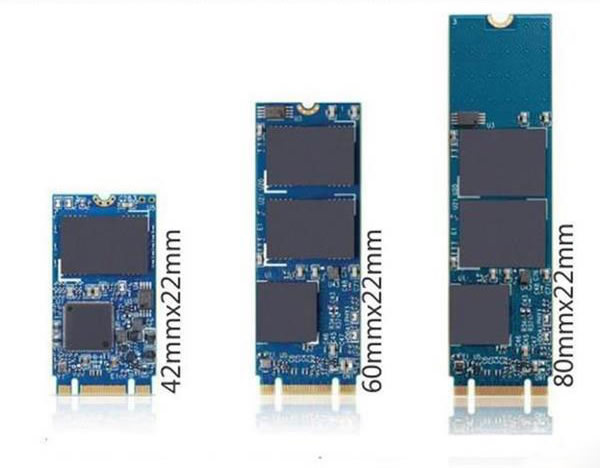Since 2015, many manufacturers have released solid state drive (SSD) with the M.2 port. The M.2 SSD is divided into two types: SATA and PCI-E. Two types have different performance even if they look the same. The M.2 port of some motherboards only supports SATA, while the M.2 port of the others only supports PCI-E. So it will cause the user much trouble if the user buys the wrong M.2 SSD type.

The M.2 is a new-generation port standard that Intel puts forward. The M.2 port boosts of faster port with the smaller volume. At present, the M.2 port has the following types with different length.
The PCI-E SSD and SATA SSD are M.2 ports, but how to differentiate them? Before figuring out this problem, we will resolve the following common problems first.
Why is the M.2 port divided into PCI-E and SATA?
That’s because two types support different channel. The M.2 provides two ports: Socket 2 and Socket 3. The Socket 2 supports the SSD with SATA PCI-Ex2 channel while the Socket 3 which is designed for high-performance storage supports PCI-Ex4 channel. The Samsung SM951 M.2 256GB SSD supports PCI-E channel, while the Samsung PM851 M.2 256GB SSD supports SATA channel. That’s the reason.
Do all the motherboards with the M.2 port?
Absolutely not. Different motherboard with the M.2 port supports different channel. Some motherboards with the M.2 port only supports PCI-E channel such as the ASUS Z97-A, and its introduction contains information on the M.2. Some support both SATA and PCI-E channel like the GIGABYTE UD3H. If the Samsung PM851 M.2 256GB SSD is installed on the ASUS Z97-A, the Samsung PM851 SSD will fail to be recognized. Such problem will not happen if the motherboard supports both channels. If you want to purchase the M.2 SSD, you need to figure out the channel that the M.2 port of your motherboard supports.
What decides the channel that the M.2 SSD supports?
Whether the M.2 SSD supports PCI-E or SATA channel depends on the main control chip. For instance, the main control of the Samsung SM951 M.2 256GB SSD is the MDX PCI-E 3.0 which is a PCI-E controller, while the Samsung PM851 M.2 uses a traditional SATA3 controller. If apply the M.2 port which supports PCI-E and SATA channel such as GIGABYTE Z97X-UD3H to two SSDs, the Z97X-UD3H can be recognized by both SSDs.
What’s the difference between PCI-E SSD and SATA SSD?
Speed depends on the M.2 channel. It is just like the huge difference in a car’s speed when it is on the highway or rough mountain road.
The SATA 3.0 channel’s theoretical broadband is 6GB/s and its theoretical limiting transferring speed is 600MB/s. Like all the SSD with the SATA port in the market, the Samsung PM851’s maximum read speed is less than 600MB/s. In the meantime, the theoretical transferring broadband of the M.2 motherboard supporting PCI-E channel is 10GB/s. The Samsung SM951 M.2 256GB SSD’s sequential read speed reaches 1600MB/s exceeding SATA3.0 SSD’ limiting transferring speed.
What’s the difference in two types’ price?
What the public concern most is the difference in their price. Of course, there is a big difference in two SSDs’ price. At present, the PCI-E SSD’s price is higher than the SATA SSD’s. The SATA M.2 SSD’s price is on the same level with the SATA SSD.
How to know whether the M.2 SSD supports PCI-E?
First of all, such information will be mentioned in the product’s production on the official website.
Secondly, such information will be found in the product’s specification or introduction on the e-commerce platforms.
Those are the difference between the M.2 SSD, PCI-E SSD and SATA SSD. The price of the M.2 SSD which supports SATA channel is lower. The M.2 SSD with small volume can be applied to a variety of super laptops. The PCI-E SSD pursues better performance and quality. The user can choose the suitable SSD based on the M.2 port of the motherboard.








